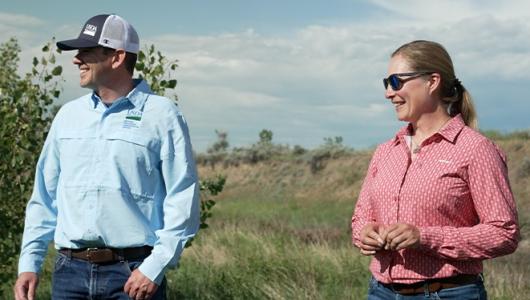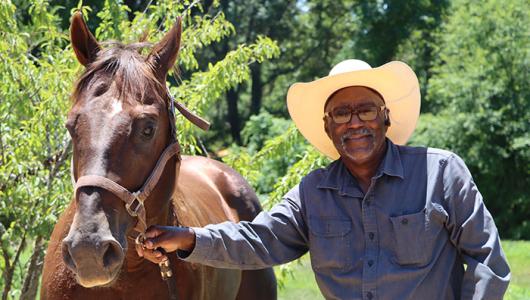Each Friday visit local farms, ranches, forests, and resource areas through our #FridaysOnTheFarm stories. Meet farmers, producers, and landowners who are working to improve their operations with USDA programs.
This Friday meet Pat and Judy McKelvey, timber producers in Jefferson County, Montana. When the couple purchased 100 acres of timbered hills, they saw both an opportunity and a retirement project.
“We acquired it about four years ago and it was not in the same kind of condition that you are looking at right now.”
Click here to read the interactive, multimedia version of this story.
Going to Work
When the McKelveys bought the property, the forest was not in good shape. There had been some logging that left high stumps, down timber, and even a broken-down skidder. Even more devastating to the area was the mountain pine beetle infestation.
“It moved through here in 2009 through 2012 in a very heavy way. We had 80 percent mortality in the lodgepole and in the ponderosa pine,” said Pat. “We were aware of that, of course, and what that meant from a fuels perspective and from a forest health issue.”
When Pat and Judy purchased the acreage, the trees had lost their needles and began to deteriorate. The trees, killed by the mountain pine beetle, had begun to fall and were stacking up.
“In this area that we’re in, you get something going in that, that’s a fire that’s going to resist suppression activities like you can’t believe,” Pat said. “Plus, it’s going to just wipe out everything in a soil component.”
The McKelveys weren’t only concerned about a fire on their property, but also worried about their neighbors. The scenery, recreational opportunities, and rural lifestyle have attracted many homeowners to the forests south of Helena.
“We wanted to achieve a lower intensity of the expected fire behavior,” Pat said. “We needed to generate some income and then we needed it to have it in a condition – forest health condition –where we can hand that down for generations.”
Spacing the Trees
USDA’s Natural Resources Conservation Service helped the McKelveys by assessing the forest resource, developing a plan based on their goals, and providing financial assistance for the implementation.
“It became obvious that we weren’t going to be able to do this on our own," said Pat. “That’s how we got into it with NRCS.”
Pat was familiar with the Environmental Quality Incentives Program through NRCS. The opportunity to apply came up with the 2016 Tenmile Creek Forestry Project, a partnership between the U.S. Forest Service and NRCS to bridge the gap in forest management between publicly-and privately-managed forestlands. Financial assistance for the initiative is provided through EQIP.
“The McKelveys’ goal was fuel mitigation. There were a lot of beetle-killed, dead, and down trees and trees growing very close together, which is ladder fuel for fire to travel both from crown to crown and along the ground,” said Nancy Sweeney, NRCS district conservationist. “It was a high priority to protect neighbors and the property boundary bordering U.S. Forest Service land.”
The NRCS specifications for the project required spacing between trees that would diminish the likelihood of a crown fire and cleaning up dead and down trees and other debris to decrease the intensity of ground fire.
Temporary Stewards
The thinning project produced a lot of slash piles that had to be cleaned up. Pat and Judy spent two winters burning close to 800 piles, many of which have been reseeded.
“It’s a much more fire-safe and more aesthetically beautiful property,” said Judy.
Pat and Judy hope that the property stays in the family for many generations to come.
“We are only temporary stewards here,” Pat said. “We want to make our next decisions on what our grandkids probably are going to have to live with.”
More Information
USDA offers a variety of risk management, disaster assistance, loan, and conservation programs to help agricultural producers in the United States. Learn about additional programs.
For more information about USDA programs and services, contact your local USDA service center.
Join the Conversation
Follow the #FridaysOnTheFarm story series and other news you can use on farmers.gov and our social media channels: Twitter, Instagram, YouTube, Flickr, and Facebook.
Story Credit: Tasha Gibby, NRCS Photo Credit: USDA NRCS


